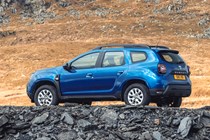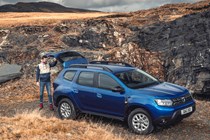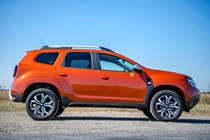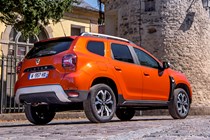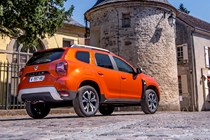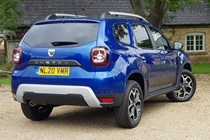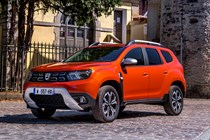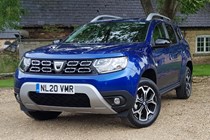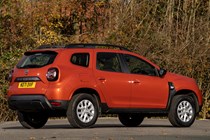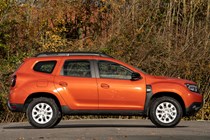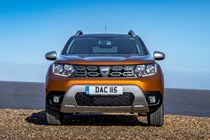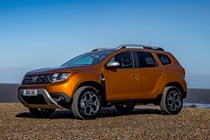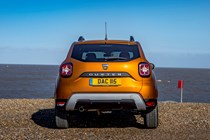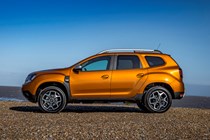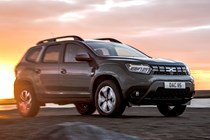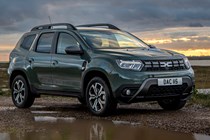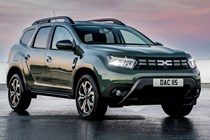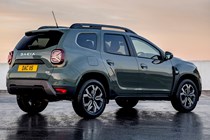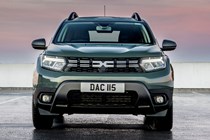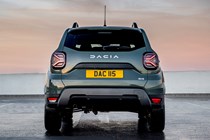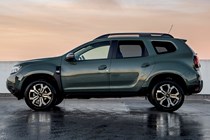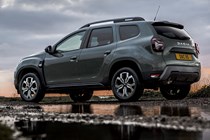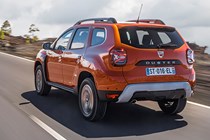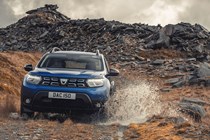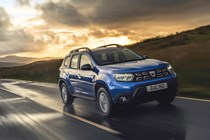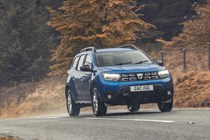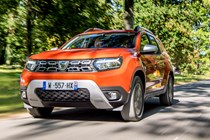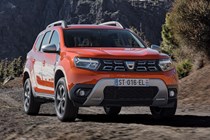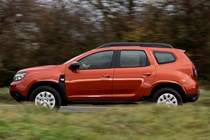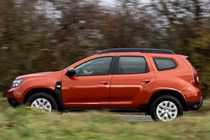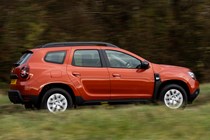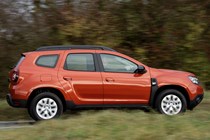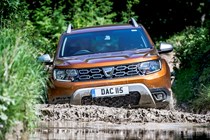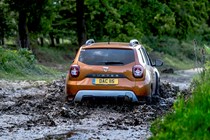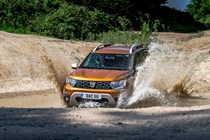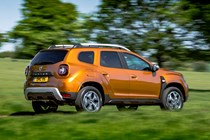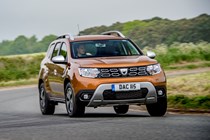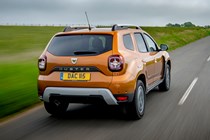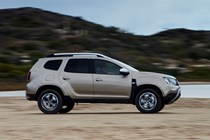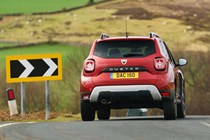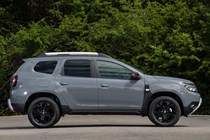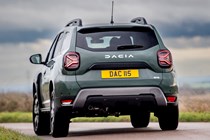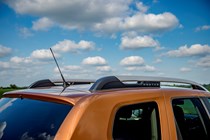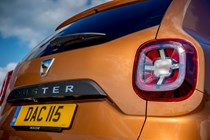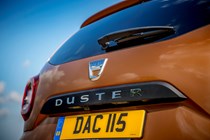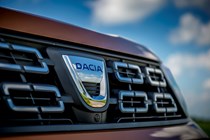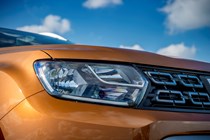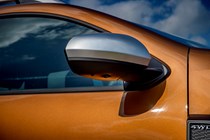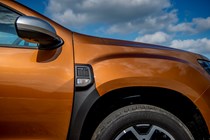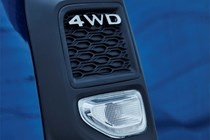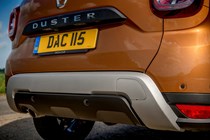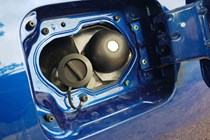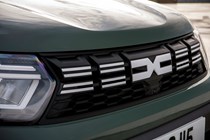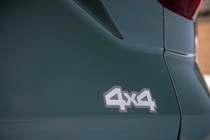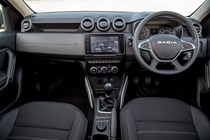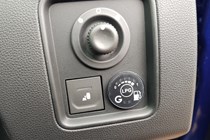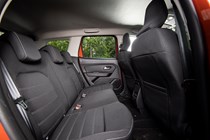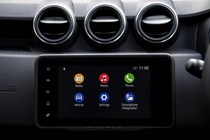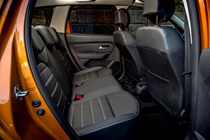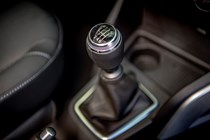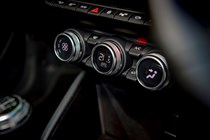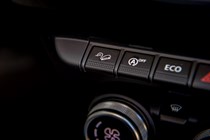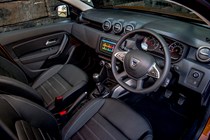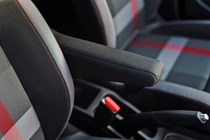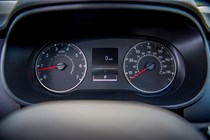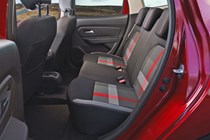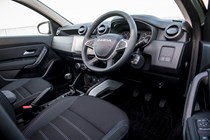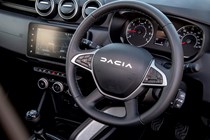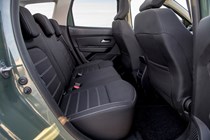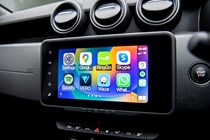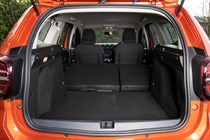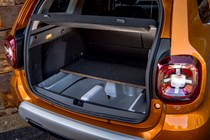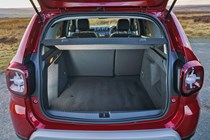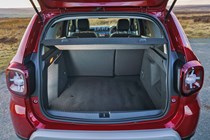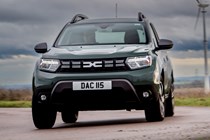Dacia Duster SUV (2018-2024) long-term test
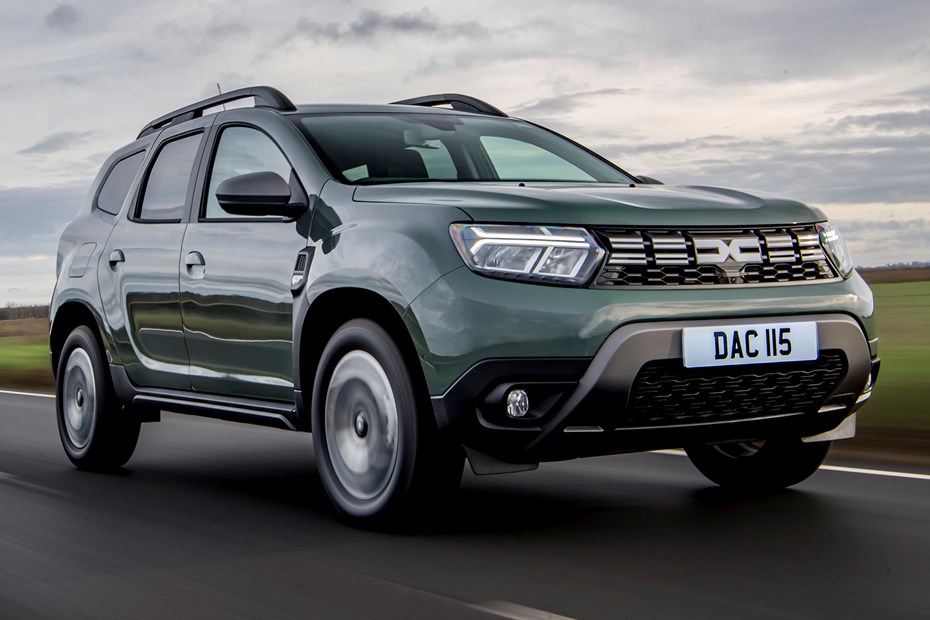
Update 1: Introduction
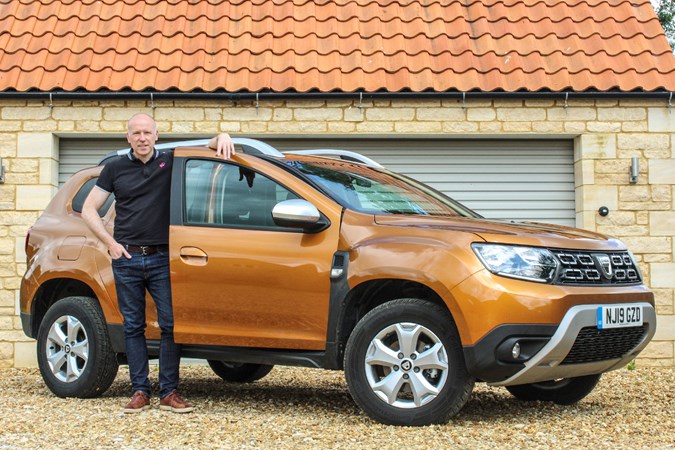
The Dacia Duster is the UK’s cheapest SUV and according to our exhaustive road tests it’s outstanding value too, so good in fact that it picked up the best off-roader gong at our Parkers New Car Awards 2019. To see if that great value translates into value day-to-day ownership we are running a Duster on the Parkers fleet for the next six months.
Although Duster prices start at an eye-rubbing £9,995 the lowest Access spec level does do without some of the modern day motoring essentials like air conditioning, so we’ve decided to plump for the Comfort TCe130 4×2. This mid-spec level gives you all the luxuries new car buyers expect today without the price rocketing out of sight.
For the on-the-road price of £14,400 you get a very respectable specification with highlights including:
- Manual air conditioning
- Media Nav with 7-inch touchscreen
- Satellite navigation
- Apple Car Play and Android Auto
- Rear Camera (includes sensors)
- Dark glass on lateral rear windows
No one is going to feel they are budget motoring with those features. We have also opted for the Metallic paint at £495 (as the only standard colour is a rather drab white) and an emergency spare wheel for a further £150, bringing our total to £15,045. Still a remarkable figure considering this is a five-door SUV with a good level of kit.
We’ve also chosen the turbocharged 1.3 TCe engine that promises 41.5 mpg under the more realistic WLTP fuel economy test conditions. It delivers 128hp driven to the front wheels – full 4x4 is another £1700 and not available with this particular trim and engine option.
First impressions
The new Duster was revealed in full at the 2017 Frankfurt motor show. Despite not a single panel being carried over from the previous car, the exterior is an evolutionary design and you’d struggle to spot the exact changes apart from the overall look being beefier and sharper. The Dacia looks larger than it actually is, as it’s actually about 20mm shorter and a 40mm narrower than a SEAT Ateca. It achieves this by stretching its deep grill and headlights to the full width of the car and using the chunky extruding wheel arches to complete the impression of bulk. It works well, as the car looks a lot more imposing that its dimensions suggest.
The Duster’s interior has been reworked substantially by Dacia to provide a more upmarket feel, not that you get a sense of that on your first impression. It has a utilitarian feel with only a few chrome flourishes. Black is the new black as far as Dacia is concerned but the colour scheme, the only colour available with this spec level, helps give the impression of mid-level quality and certainly not what you’d think was a budget interior.
We know from our road tests that the Dacia has a pretty comfortable and refined ride but is will be interesting in the coming months to see how it copes with my notorious local country roads. That ride will be tested to the maximum.
Mileage: 1,310
Indicated mpg: 40.5
Update 2: Practicality and comfort
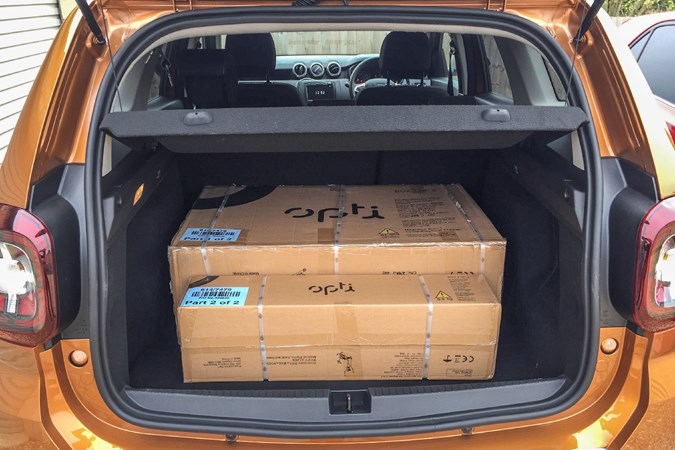
Not long after the Duster’s arrival it was deployed on a couple of long motorway journeys. The occasion was my football team had made it to the league play-offs so the Duster was full of excitable footy fans for two 150-mile plus journeys. The comments coming in from around the car were overwhelmingly positive, unprompted a few people mentioned the quietness of the car on the motorway and how smooth the ride was.
It’s true, the Duster doesn’t seem to have skimped when it comes to sound deadening – road noise levels are at least comparable to other mid range rivals and better than some more expensive alternatives. The ride is impressive too, especially when tackling more uneven road surfaces. I suspect a lot of that may be down to the smaller 16-inch wheels. In what is a rarity nowadays this Duster is fitted with tyres that are anything but low profile.
It may be unfashionable but it’s a great reminder how much a simple fatter tyre can help improve your car’s ride quality. By comparison, my wife has a three-year-old Range Rover Evoque fitted with wider and lower profile tyres. Despite the huge price difference when new the Duster at least matched the Evoque on tyre noise and ride, in a few circumstances I thought the Duster was better.
Keeping rear-seat passengers happy
We were victorious in both matches and through to the final, so I thought perhaps the rear seat passengers may have been more forgiving in their appraisal of legroom when I quizzed them. They seemed very happy and comfortable but was it post match victory glow? When the car first arrived, I hopped in the back and my first impression was the space was not over-generous. Fine for the children, but adults might be complaining. After a few more grumble-free journeys with grown-ups in the back I might have judged the rear interior space too harshly, although it’s not been tested with anybody you might describe as tall.
My children report that the rear seats are very comfortable and that echoes my front-seat evaluation. I was able to find the perfect driving position despite my higher than average height of nearly six foot. There is also lumbar support adjustment and an armrest to the left of the driver, combined with the extra height an SUV gives you it’s a pleasant and relaxing driving position.
What the Duster may lack in rear legroom, it makes up in boot space. While on paper it’s nothing spectacular compared to the rivals it does give the impression of being a larger than average boot. It’s not particularly wide but does go deep into the car and that has made it impressively practical. As with most cars nowadays the rear seats fold almost flat with a pull of a single lever. It’s swallowed the average family diet of trips to dump, suitcases on holiday and trips back from the DIY store with zero fuss.
When it comes to both practicality and comfort the Duster is very much like my team in their subsequent Wembley final – victorious. The budget price doesn’t mean you have to slum it with inferior refinement or usability.
- Mileage: 1,937
- Calculated mpg: 41.3
Update three: Interior
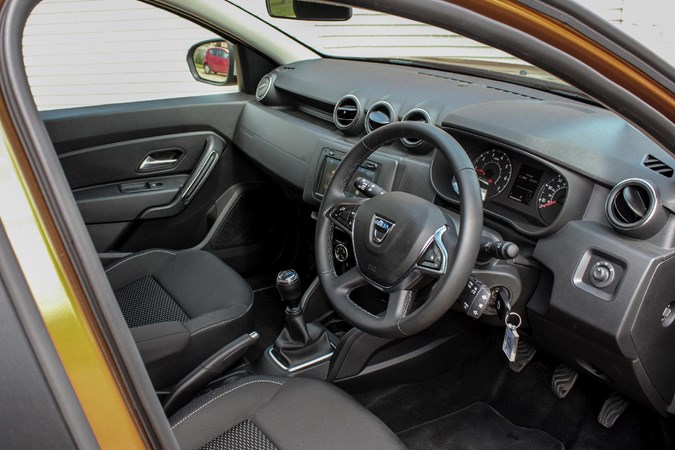
As I’ve mentioned previously the all-new Duster arrived back in 2017 and with it came a very different interior. Gone was the rather clumsy, bulbous dashboard and in its place came a sleeker, simpler design – it’s a pleasant mix of utilitarian chic and understated geometric lines. The cabin is still littered with harder, cheaper plastics but Dacia’s dedication to shading every surface solid black hides the low-cost materials very well. There is the odd fascia finished in a softer, matt and more expensive texture but the upgrade from the standard harder plastic is minimal and hard to spot.
I’ve already praised the comfortable seats and that’s partly down to a fully adjustable driving position. The steering wheel has rake and reach movement, plus the seats also come with height and lumbar support variance. I was quickly able to get my perfect driving set-up and with the aid of an armrest on the left-hand side I felt snug and relaxed, especially on longer journeys.
Our Comfort spec car comes with a MediaNav Evolution 7.0-inch touchscreen multimedia system. It’s a competent unit that appears very similar to the majority of its more expensive rivals. The low screen brightness might be the only criticism although I’ve had no problems when the rear-parking camera flicks on in reverse. Anytime night or day the combination of camera and screen has always offers a crystal clear view.
Working my way through the menus on screen is pretty standard multimedia fare and to be honest rarely gets used. The car is equipped with Apple CarPlay/Android Auto and the much more intuitive sat nav and voice activated controls provided by Apple and Android are always my preference. In fact it was a good few months after taking delivery that I bothered to pair my phone via Bluetooth, so good are the phone controls that I wonder if manufacturers are wasting their time trying to compete with smart phone equivalent interfaces.
When living with this car I’ve spent a lot of my time shaking my head in disbelief with how good it is for the price, but when it comes to the interior the Duster is not absolutely faultless. There are some very odd ergonomic decisions that make you wonder how they ever made it into production.
Firstly the position of the USB socket to plug your smartphone into for Apple Carplay/Android Auto is above the screen. This means you have the USB wire dangling in it whenever plugged in. At first this seemed like pure madness until I noticed a groove cut into the top of the dash above the screen. It’s obviously designed to allow a smartphone to rest in a prime head height viewing area. That’s fine in principle but the first time I accelerated slightly harder than normal the phone flew off the ledge and onto the floor. It was never placed there again. But even if the phone was secure enough on that ledge the USB cable would still dangle in front of the multimedia screen, that’s unless you managed to purchase a ridiculously short cable.
Secondly you have to flick a switch near the handbrake to activate the cruise control. At first this had me completely flummoxed as all other cruise controls are located on the steering wheel. I had to refer to the manual to get the system working.
Overall the quality of the Duster’s interior doesn’t feel like you’re bargain-basement motoring. While not quite hitting the heights of the other mid-price rivals it doesn’t feel and look cheap, certainly when you consider how competitive the cost of the car actually is. There are some quirky design decisions but in general it’s a comfortable place to be with enough tech and kit to keep up with its rivals.
- Mileage 3423
- Calculated MPG 40.2
Update four: Performance and handling
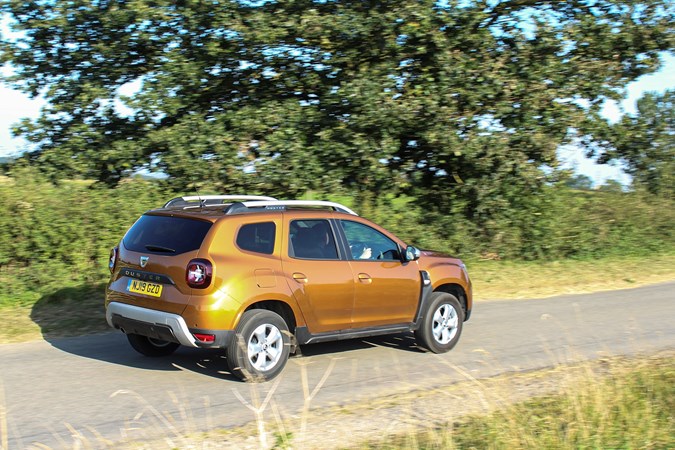
Our Duster is fitted with the new for 2019 1.3 litre turbocharged engine. The unit produces 130hp and despite its small capacity feels nippy and responsive. You can hear the faint hum of the turbocharger spinning in the background most of the time and means there’s very little lag when you do put your foot down. Acceleration is reasonably brisk if not always completely smooth. Often there is a slight jump in revs when starting to accelerate as if the engine is a bit too eager. That briskness is achieved in part by one of the lowest kerb weights for this class, being 100 to 300kg lighter than most of the competition. It means there’s less for the engine to haul around and does make Duster feel light on its feet. The gearbox is slick and has the welcome addition of sixth gear for faster roads.
Another benefit of a low mass is healthy fuel consumption figures. I regularly achieved the claimed 41mpg to start with until my heavy right foot got the better of me. Even so I’m still consistently registering around 38mpg now I’ve become a bit more overzealous with the accelerator. I think that’s a notable achievement for a chunky, petrol driven SUV. My only gripe as far as the engine is concerned is the stop-start system. For the majority of the time it’s faultless but occasionally it will catch me out. It can be a fraction of a second late to kick in when coming to a stop and that sometimes coincides with me trying to pull away again. The result is a briefly stalled engine and missing my gap in the traffic. It happens a couple of times within a weeks driving, which is just enough to be annoying.
A lot of the Duster’s miles have been undertaken on rural lanes so the handling has already experienced the full array of road types. The Dacia has coped well, keeping composed when cornering and offering a good level of grip, even with the car’s two-wheel drive. There is body roll but nothing out of the ordinary for a tall SUV with a softer ride. The car has the tendency to dive under braking, caused by there being disc brakes on the front wheels and less able drum brakes on the rear. The steering is neither super precise or particularly vague, in fact there are a lot of very average aspects to the handling of this car. What’s makes the Duster so compelling is the low price of this car shames so many more expensive, equally average handling cars.
After saying that the handling is average, my recent change in driving style that’s worsened my mpg figures has been the result of me feeling a lot more confident in the Duster’s abilities. I’ve started to chuck the car around a little more knowing the car will cope. It may not have the most sophisticated suspension, ride and handling but the combination of a willing engine and a low kerb weight has started to make the Duster fun to drive, more than you would expect from a family SUV.
- Mileage 3,423
- Calculated mpg 38.4
Update five: Dacia Duster vs the rivals
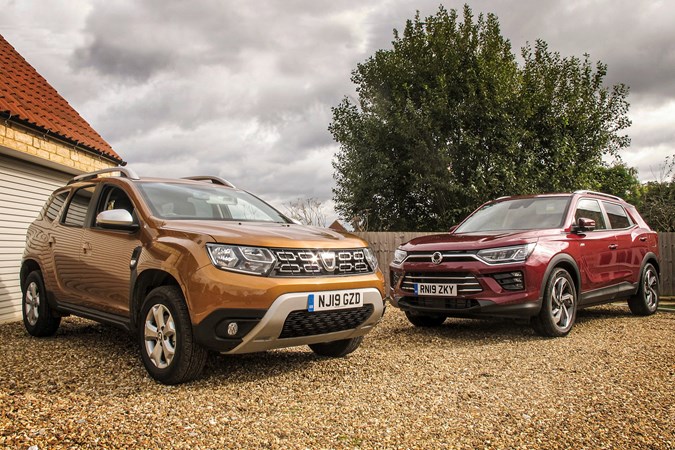
Because of its incredibly low price the Duster doesn’t have many direct rivals. In fact the only other car to come close is the MG ZS. It’s a SUV of similar proportions with an equally keen price. We think our TCe 130 4×2 Comfort hits the sweet spot from the small Duster range. It has all the creature comforts owners expect from a new car but still keeps the price very low. A similar model in the ZS range will set you back another £1,000 if you’re buying cash. If you’re buying with a PCP (personal contract purchase) like most people will, then the monthly payments work out roughly the same.
While they’re pretty evenly matched in many areas the Duster still comes out on top thanks to a much punchier performance with its new for 2019 130hp engine. That’s compared to the 110hp found in a 1.0T GDI Excite grade ZS. You only have to look at the ZS’s 13.1sec 0-60 time to appreciate that the MG can be frustratingly sluggish. Meanwhile the Duster’s 0-60 time of 9.9sec underlines our experience of an engine that makes the car nippy and responsive. It also gives you the bonus of posting better mpg figures that the MG too. Added to this the Duster has a more comfortable ride.
Another pertinent question when considering a Duster is just how superior are the mid priced SUVs for all that extra outlay. I recently drove a new entry into that crowded SUV market back to back with the Duster. The all-new SsangYong Korando has been completely reinvented for 2019. SsangYong has always been on the budget side of the SUV market and has less badge kudos than most of its rivals. That makes it an ideal candidate to compare with the Duster’s value for money ethos.
The first thing to say is that the cheapest model in the Korando range is still nearly £5,000 more than our mid-spec Duster model. For that the Korando ELX is pretty sparse inside, there is no infotainment touchscreen, sat-nav or Apple Carplay/Andriod Auto. What you do get is a more smartly-designed interior with chrome and piano black finishes mixed with some of the hard black plastics that are found in the Duster. It’s a clear step up from the Duster but to get that same level interior kit of sat-navs and Apple CarPlay/Android Auto you’ve got to pay £26,495 for the pioneer model. Another noticeable difference between both cars is ride and comfort. The Korando has a much more subtle ride, smoothing out bumps in the road with a sophisticated verve. The cabin is a quieter place to be too, especially on the motorway where tyre and wind noise is kept to a minimum.
The largest gap in the two models though is safety. The Korando has as standard across the range safety systems such as autonomous emergency braking, lane departure warning and even lane keeping assist (a system where the steering wheel is gently corrected if you’re drifting towards the edge of your lane). These are fast becoming the standard on most mid priced new cars. Our Duster has emergency brake assist but it’s not as sophisticated as the SsangYong autonomous system and there’s only a blind spot warning systems added to the next Prestige grade. There’s also the Euro NCAP rating (New Car Assessment Programme) to consider. The Duster scores just three stars, which is a low score in today’s market. The Korando scores the maximum of five.
So as expected the Duster does make several compromises to hit its appealing price point. Though many potential owners will feel they can do without the small upgrades in quality, especially when the price is this competitive. The Duster is still outstanding value for money. The only concern is the lack of safety features and ratings. That may be a price some buyers are not willing to sacrifice.
- Mileage 5,687
- Calculated mpg 38.9
Update six: Verdict
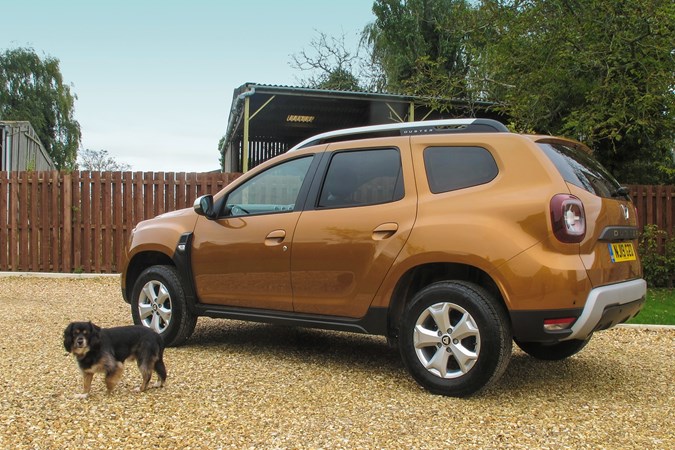
Our six-month test of the Dacia Duster is at an end and it’s time to give our verdict. The Parkers New Car Awards 2019 winner appears to be a great value for money but how does this translate into day-to-day ownership, does the low price mean it’s a less durable car? Drum roll please, the results are in.
- See what won the 2020 Parkers Off-Roader of the Year award here
First up for evaluation is the comfort and ride. In my first report passengers praised the quietness and smoothness of ride on the motorway. I also thought the ride was pretty competent over rougher roads too. Six months later and my opinion is roughly the same. The only change to that assessment is the way the Duster tackles rougher road surfaces. It’s now not so smooth when it hits more challenging undulations, with jittery feedback and a low-level rattily noise. It just doesn’t feel as accomplished as mid priced rivals. Also there’s an annoying, barely audible rattle coming from the back that if I had the car longer I would have taken to the dealer to investigate.
The performance and handling of the Duster made a good impression on me when it first arrived. The Engine is punchy despite its small capacity and the handling is capable for a tall SUV. What has stood out over the six months is how light the car feels. Its relatively low kerb weight makes the Duster more agile when cornering and brisk when accelerating. I spoke to an editor of a performance car magazine who’d had a Duster hire car while on holiday. He was raving about his experience, which is quite a compliment for a person who is usually test-driving Ferrari and Porsches. It makes sense though, as two qualities that make a great sports car is lightness and their simplicity, qualities the Duster has probably as a necessity to keep the price down rather than design. Never the less it turns out to be two of the Dusters better aspects.
I’ve been impressed with the Duster’s seats from day one. For someone of advancing years I suffer from the odd bit of back pain and I’m particularly sensitive to car seat comfort. The Duster has adjustable lumber support plus rake and reach steering wheel adjustment. It’s meant it’s the most comfortable I’ve been in car for some time. I earlier described the interior design as mix of simplicity and utilitarian with swathes of black and more even black. That look didn’t do such a great job of disguising this Duster’s heavy workload. With regular pick-ups of my daughter from the riding stables the Duster was difficult to keep clean. Those large areas of hard plastic didn’t disguise the mud, dust and straw that was regularly dumped on it. I’ve come to the conclusion the interior is probably just a bit too basic looking for it’s own good.
Running costs have been superb, despite its responsive engine and my heavy right foot I’ve never posted lower than 38mpg and when driving in a more sedate manner regularly posted the claimed 41mpg. Combined with the finance deals available this is a very economical car to live with.
So has the Duster pulled off the impossible and offered a car that hides the fact it’s a fraction of the price of most of it’s rivals? Well, nearly. The ride isn’t quite as robust as the mid price rivals and the interior is just a touch too basic. So no, Dacia hasn’t pulled off the impossible but it still offers a usable and comfortable SUV that excels in its duties compared to the cost of ownership. The acid test for road testers to commit to is would you buy one, well, in a word, yes. To justify that statement my self-confessed badge snob wife was so impressed she has the Duster at the top of her shortlist to replace her PCP Range Rover Evoque next month. The amount of car she would get for the fraction of cost has won her over.
- Final mileage 6,736
- Final calculated mpg 39.7



